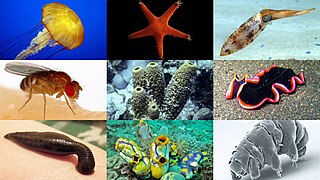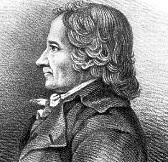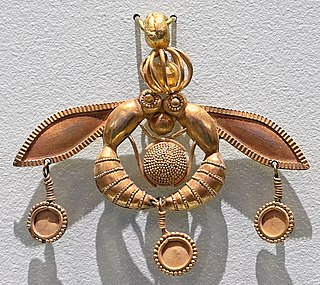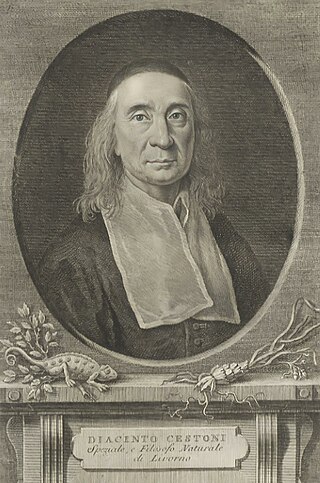Related Research Articles

Invertebrates is an umbrella term describing animals that neither develop nor retain a vertebral column, which evolved from the notochord. It is a paraphyletic grouping including all animals excluding the chordate subphylum Vertebrata, i.e. vertebrates. Well-known phyla of invertebrates include arthropods, mollusks, annelids, echinoderms, flatworms, cnidarians, and sponges.

Linnaean taxonomy can mean either of two related concepts:
- The particular form of biological classification (taxonomy) set up by Carl Linnaeus, as set forth in his Systema Naturae (1735) and subsequent works. In the taxonomy of Linnaeus there are three kingdoms, divided into classes, and the classes divided into lower ranks in a hierarchical order.
- A term for rank-based classification of organisms, in general. That is, taxonomy in the traditional sense of the word: rank-based scientific classification. This term is especially used as opposed to cladistic systematics, which groups organisms into clades. It is attributed to Linnaeus, although he neither invented the concept of ranked classification nor gave it its present form. In fact, it does not have an exact present form, as "Linnaean taxonomy" as such does not really exist: it is a collective (abstracting) term for what actually are several separate fields, which use similar approaches.
In biology, taxonomy is the scientific study of naming, defining (circumscribing) and classifying groups of biological organisms based on shared characteristics. Organisms are grouped into taxa and these groups are given a taxonomic rank; groups of a given rank can be aggregated to form a more inclusive group of higher rank, thus creating a taxonomic hierarchy. The principal ranks in modern use are domain, kingdom, phylum, class, order, family, genus, and species. The Swedish botanist Carl Linnaeus is regarded as the founder of the current system of taxonomy, as he developed a ranked system known as Linnaean taxonomy for categorizing organisms and binomial nomenclature for naming organisms.

Emil Hans Willi Hennig was a German biologist and zoologist who is considered the founder of phylogenetic systematics, otherwise known as cladistics. In 1945 as a prisoner of war, Hennig began work on his theory of cladistics, which he published in German in 1950, with a substantially revised English translation published in 1966. With his works on evolution and systematics he revolutionised the view of the natural order of beings. As a taxonomist, he specialised in dipterans.
Zoology is the scientific study of animals. Its studies include the structure, embryology, classification, habits, and distribution of all animals, both living and extinct, and how they interact with their ecosystems. Zoology is one of the primary branches of biology. The term is derived from Ancient Greek ζῷον, zōion ('animal'), and λόγος, logos.

Entomology is the scientific study of insects, a branch of zoology. In the past the term insect was less specific, and historically the definition of entomology would also include the study of animals in other arthropod groups, such as arachnids, myriapods, and crustaceans. This wider meaning may still be encountered in informal use.

Jan or Johannes Swammerdam was a Dutch biologist and microscopist. His work on insects demonstrated that the various phases during the life of an insect—egg, larva, pupa, and adult—are different forms of the same animal. As part of his anatomical research, he carried out experiments on muscle contraction. In 1658, he was the first to observe and describe red blood cells. He was one of the first people to use the microscope in dissections, and his techniques remained useful for hundreds of years.

Johan Christian Fabricius was a Danish zoologist, specialising in "Insecta", which at that time included all arthropods: insects, arachnids, crustaceans and others. He was a student of Carl Linnaeus, and is considered one of the most important entomologists of the 18th century, having named nearly 10,000 species of animals, and established the basis for the modern insect classification.
William Elford Leach was an English zoologist and marine biologist.

Alpheus Spring Packard Jr. LL.D. was an American entomologist and palaeontologist. He described over 500 new animal species – especially butterflies and moths – and was one of the founders of The American Naturalist.

Johannes Goedaert was a Dutch naturalist, entomologist and painter, famous for his illustrations of the growth and metamorphosis of insects published in a three volume work as Metamorphosis Naturalis. He was one of the earliest authors on entomology and first to write on the insects of the Netherlands and Europe, based on his own observations and experiments between 1635 and 1667.

Entomology, the scientific study of insects and closely related terrestrial arthropods, has been impelled by the necessity of societies to protect themselves from insect-borne diseases, crop losses to pest insects, and insect-related discomfort, as well as by people's natural curiosity. Though many significant developments in the field happened only recently, in the 19th–20th centuries, the history of entomology stretches back to prehistory.

Diacinto Cestoni was an Italian naturalist, biologist, botanist, entomologist. Born in Montegiorgio, he was self-taught. He lived and worked at Livorno where he led an apothecary next to the port. He studied insects, animals, plants and drugs. Cestoni showed that scabies is caused by Sarcoptes scabiei.
The following outline is provided as an overview of and topical guide to zoology:

Marine invertebrates are the invertebrates that live in marine habitats. Invertebrate is a blanket term that includes all animals apart from the vertebrate members of the chordate phylum. Invertebrates lack a vertebral column, and some have evolved a shell or a hard exoskeleton. As on land and in the air, marine invertebrates have a large variety of body plans, and have been categorised into over 30 phyla. They make up most of the macroscopic life in the oceans.
This is a chronologically organized listing of notable zoological events and discoveries.

Worms are many different distantly related bilateral animals that typically have a long cylindrical tube-like body, no limbs, and usually no eyes.

Crustaceans are invertebrate animals that constitute one group of arthropods that are a part of the subphylum Crustacea, a large, diverse group of mainly aquatic arthropods including decapods, seed shrimp, branchiopods, fish lice, krill, remipedes, isopods, barnacles, copepods, opossum shrimps, amphipods and mantis shrimp. The crustacean group can be treated as a subphylum under the clade Mandibulata. It is now well accepted that the hexapods emerged deep in the Crustacean group, with the completed pan-group referred to as Pancrustacea. The three classes Cephalocarida, Branchiopoda and Remipedia are more closely related to the hexapods than they are to any of the other crustaceans.

Le Règne Animal is the most famous work of the French naturalist Georges Cuvier. It sets out to describe the natural structure of the whole of the animal kingdom based on comparative anatomy, and its natural history. Cuvier divided the animals into four embranchements, namely vertebrates, molluscs, articulated animals, and zoophytes.
Gonzalo Giribet is a Spanish-American invertebrate zoologist and Alexander Agassiz Professor of zoology working on systematics and biogeography at the Museum of Comparative Zoology in Harvard University. He is a past president of the International Society for Invertebrate Morphology, of the Willi Hennig Society, and vice-president of the Sociedad Española de Malacología.
References
- ↑ May, Robert M. (16 September 1988). "How Many Species Are There on Earth?". Science. 241 (4872): 1441–1449. Bibcode:1988Sci...241.1441M. doi:10.1126/science.241.4872.1441. JSTOR 1702670. PMID 17790039. Archived from the original on 15 November 2016. Retrieved 7 July 2014.
- ↑ Weiss, Harry B. (1927-01-01). "Four Encyclopedic Entomologists of the Renaissance". Journal of the New York Entomological Society. 35 (2): 193–207. JSTOR 25004198.
- ↑ NERI, JANICE (2008-01-01). "Between Observation and Image: Representations of Insects in Robert Hooke's "Micrographia"". Studies in the History of Art. 69: 82–107. JSTOR 42622433.
- 1 2 Egerton, Frank N. (2005-01-01). "A History of the Ecological Sciences, Part 17: Invertebrate Zoology and Parasitology during the 1600s". Bulletin of the Ecological Society of America. 86 (3): 133–144. doi:10.1890/0012-9623(2005)86[133:AHOTES]2.0.CO;2. JSTOR bullecosociamer.86.3.133.
- ↑ Cobb, Matthew (2000-09-01). "Reading and writing The Book of Nature: Jan Swammerdam (1637–1680)". Endeavour. 24 (3): 122–128. doi:10.1016/S0160-9327(00)01306-5.
- ↑ Beier, Max. "The Early Naturalists and Anatomists During the Renaissance and Seventeenth Century." In History of Entomology, edited by Ray F. Smith, Thomas E. Mittler, and Carroll N. Smith, 90. Palo Alto: Annual Reviews, Inc, 1973.
- 1 2 3 4 Egerton, Frank N. (2008-10-01). "A History of the Ecological Sciences, Part 30: Invertebrate Zoology and Parasitology During the 1700s". The Bulletin of the Ecological Society of America. 89 (4): 407–433. doi:10.1890/0012-9623(2008)89[407:AHOTES]2.0.CO;2. ISSN 2327-6096.
- 1 2 Reid, Gordon McGregor (2009-01-01). "Carolus Linnaeus (1707-1778): His Life, Philosophy and Science and Its Relationship to Modern Biology and Medicine". Taxon. 58 (1): 18–31. doi:10.1002/tax.581005. JSTOR 27756820.
- 1 2 Winsor, Mary P. (1976-01-01). "The Development of Linnaean Insect Classification". Taxon. 25 (1): 57–67. doi:10.2307/1220406. JSTOR 1220406.
- ↑ Tuxen, S L. "Entomology Systematizes and Describes: 1700-1815." In History of Entomology, edited by Ray F. Smith, Thomas E. Mittler, and Carroll N. Smith, 107. Palo Alto: Annual Reviews, Inc, 1973.
- ↑ Ross, Herbert H. "Evolution and Phylogeny." In History of Entomology, edited by Ray F. Smith, Thomas E. Mittler, and Carroll N. Smith, 171-84. Palo Alto: Annual Reviews, Inc, 1973.
- ↑ Clark, John F. Bugs and the Victorians. New Haven: Yale University Press, 2009.
- ↑ Richter, Stefan; Meier, Rudolf (1994-01-01). "The Development of Phylogenetic Concepts in Hennig's Early Theoretical Publications (1947-1966)". Systematic Biology. 43 (2): 212–221. doi:10.2307/2413462. JSTOR 2413462.
- ↑ "Japanese Spider Crab - Macrocheira kaempferi - Details - Encyclopedia of Life". Encyclopedia of Life. Retrieved 22 May 2017.
- ↑ "Lion's Mane Jellyfish - Cyanea capillata - Details - Encyclopedia of Life". Encyclopedia of Life. Retrieved 22 May 2017.
- ↑ "Oceanic Squid - Architeuthis dux - Details - Encyclopedia of Life". Encyclopedia of Life. Retrieved 22 May 2017.